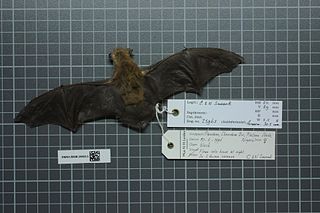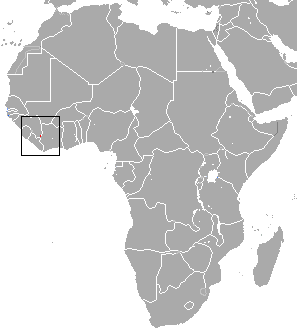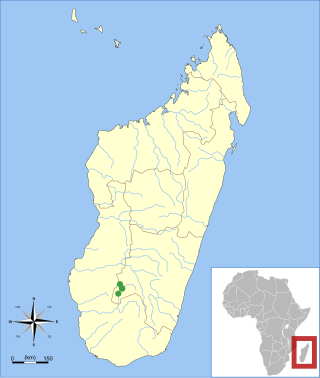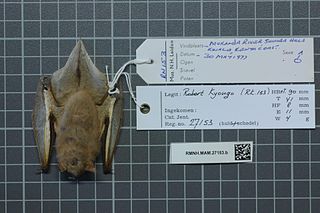
Vespertilionidae is a family of microbats, of the order Chiroptera, flying, insect-eating mammals variously described as the common, vesper, or simple nosed bats. The vespertilionid family is the most diverse and widely distributed of bat families, specialised in many forms to occupy a range of habitats and ecological circumstances, and it is frequently observed or the subject of research. The facial features of the species are often simple, as they mainly rely on vocally emitted echolocation. The tails of the species are enclosed by the lower flight membranes between the legs. Over 300 species are distributed all over the world, on every continent except Antarctica. It owes its name to the genus Vespertilio, which takes its name from a word for bat, vespertilio, derived from the Latin term vesper meaning 'evening'; they are termed "evening bats" and were once referred to as "evening birds".

Pipistrellus is a genus of bats in the family Vespertilionidae and subfamily Vespertilioninae. The name of the genus is derived from the Italian word pipistrello, meaning "bat".

Schlieffen's serotine, also known as Schlieffen's bat or Schlieffen's twilight bat, is a species of vesper bat found in Africa. It has been placed in numerous genera since its first description in 1859, but morphological and genetic studies have confirmed it as the only species in the genus Nycticeinops. It is named for the collector of the original specimen, Wilhelm von Schlieffen-Schlieffiennburg.

Anchieta's serotine, formerly known as Anchieta's pipistrelle, is a species of vesper bat. It is found in Angola, Democratic Republic of the Congo, South Africa, Zambia, Zimbabwe and Madagascar. The species inhabits savanna habitats.
The dark-brown serotine is a species of vesper bat found in Central and West Africa.

Neoromicia is a genus of vesper bat in the family Vespertilionidae. It contains the following species:

The Cape serotine is a species of vesper bat occurring in Sub-Saharan Africa. 'Serotine' is from Latin 'serotinus' meaning ‘of the evening'.

Lamotte's roundleaf bat is a species of bat found only at Mount Nimba on the border of Côte d'Ivoire, Guinea and Liberia. It is critically endangered.

The genus Hypsugo contains many bats referred to as pipistrelles or pipistrelle bats. They belong to the family Vespertilionidae or vesper bats. They are primarily found throughout Asia, the Middle East, Mediterranean Europe, and North Africa, with a single (debated) species in Sub-Saharan Africa.

The Vespertilioninae are a subfamily of vesper bats from the family Vespertilionidae.

Laephotis is a genus of bats in the family Vespertilionidae. Species within this genus are:

Nycticeinops is a genus of vesper bat in the family Vespertilionidae. It contains the following species:

Pipistrellus raceyi, also known as Racey's pipistrelle, is a bat from Madagascar, in the genus Pipistrellus. Although unidentified species of Pipistrellus had been previously reported from Madagascar since the 1990s, P. raceyi was not formally named until 2006. It is apparently most closely related to the Asian species P. endoi, P. paterculus, and P. abramus, and its ancestors probably reached Madagascar from Asia. P. raceyi has been recorded at four sites, two in the eastern and two in the western lowlands. In the east, it is found in open areas and has been found roosting in a building; in the west it occurs in dry forest. Because of uncertainties about its ecology, it is listed as "Data Deficient" on the IUCN Red List.

The Isalo serotine is a vesper bat of Madagascar in the genus Laephotis. It is known only from the vicinity of the Isalo National Park in the southwestern part of the island, where it has been caught in riverine habitats. After the first specimen was caught in 1967, it was described as a subspecies of Eptesicus somalicus in 1995. After four more specimens were collected in 2002 and 2003, it was recognized as a separate species. Because of its small distribution and the threat of habitat destruction, it is considered "vulnerable" in the IUCN Red List.
The isabelline white-winged serotine is a species of West African bat belonging to the genus Neoromicia. It is found in Guinea.
The Kirindy serotine is a species of vesper bat in the family Vespertilionidae. It occurs in the central and south-central portions of western Madagascar. As of the most recent IUCN assessment in May 2016, it is of least concern.

Pseudoromicia is a genus of vesper bat in the family Vespertilionidae. All species in this genus are native to sub-Saharan Africa.

Vespertilionini is a tribe of bats in the family Vespertilionidae. The largest of the tribes in Vespertilioninae, it contains many genera found throughout the Old World and Australasia.












